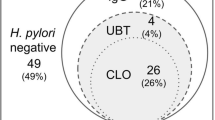Abstract
Rapid diagnostic tools for Helicobacter pylori are important in endoscopy. To assess the accuracy of a new 5-min rapid urease test (UFT300, ABS Cernusco, sul Naviglio, Italy) compared with the 1-h Pyloritek (Serim Laboratories, Elkhart, IN) and the 24-h CLO test (Kimberly-Clark Ballard Medical Products, Roswell, GA), consecutive dyspeptic patients referred to our unit for endoscopy were prospectively studied. All patients underwent a 13C-urea-breath test, histology and the UFT300 (ABS; Cernusco, sul Naviglio, Italy). Two additional rapid urease tests were performed. Patients were deemed infected when both 13C-UBT and histology were positive. Rapid urease tests were read at 1, 5, and 60 min, respectively. Of the 375 enrolled patients, 45.3% were infected with H. pylori. The sensitivity of the new 5-min rapid urease test 300 was 90.3, 94.5, and 96.2% at 1, 5, and 60 min, respectively (specificity 100%). The Pyloritek and the new 5-min rapid urease test were comparable, but the CLO test was not reliable at 5 and 60 min. In conclusion, the new 5-min rapid urease test is comparable to the Pyloritek test, but the CLO test is significantly less sensitive at early time points. Reading the test results at 1 min may increase false-negative results with decreasing sensitivity.

Similar content being viewed by others
References
Tack J, Talley NJ, Camilleri M et al (2006) Functional gastroduodenal disorders. Gastroenterology 130:1466–1479
Ford AC, Moayyedi P (2008) Current guidelines for dyspepsia management. Dig Dis 26:225–230
Talley NJ, Vakil NB, Moayyedi P (2005) American gastroenterological association technical review on the evaluation of dyspepsia. Gastroenterology 129:1756–1780
NICE Clinical Guideline no. 17: Managing of dyspepsia in primary care. http://www.nice.org.uk:80/guidance/index.jsp?action=byID&r=true&o=10950
Lieberman D, Fennerty MB, Morris CD et al (2004) Endoscopic evaluation of patients with dyspepsia: results from the national endoscopic data repository. Gastroenterology 127:1067–1075
Sung J (2007) Endoscopy is necessary before treating Helicobacter pylori in patients with dyspepsia. Am J Gastroenterol 102:473–474
Ricci C, Holton J, Vaira D (2007) Diagnosis of Helicobacter pylori: invasive and non-invasive tests. Best Pract Res Clin Gastroenterol 21:299–313
Puetz T, Vakil N, Phadnis S et al (1997) The PyloriTek test and the CLO test: accuracy and incremental cost analysis. Am J Gastroenterol 92:254–257
Dixon MF, Genta RM, Yardley JH et al (1996) Classification and grading of gastritis: the updated Sydney System. Am J Surg Pathol 20:1161–1181
Gatta L, Ricci C, Tampieri A et al (2006) Accuracy of breath tests using low doses of 13C-urea to diagnose Helicobacter pylori infection: a randomised controlled trial. Gut 55:457–462
Malfertheiner P, Megraud F, O’Morain C et al (2007) Current concepts in the management of Helicobacter pylori infection: the Maastricht III Consensus Report. Gut 56:772–781
Gatta L, Vakil N, Leandro G et al (2010) Sequential therapy or triple therapy for Helicobacter pylori infection: systematic review and meta-analysis of randomized controlled trials in adult and children. Am J Gastroenterol (in press)
Bossuyt PM, Reitsma JB, Bruns DE et al (2003) Standards for reporting of diagnostic accuracy towards complete and accurate reporting of studies of diagnostic accuracy: the STARD initiative. BMJ 326:41–44
Newcombe RG, Altman DG (2000) Proportion and their differences. In: Altman DG, Machin D, Trevor NB, Gardner MJ (eds) Statistics with confidences, 2nd edn. BMJ Books, London
Altman DG (2000) Diagnostic tests. In: Altman DG, Machin D, Trevor NB, Gardner MJ (eds) Statistics with confidences, 2nd edn. BMJ Books, London
Mulherin SA, Miller WC (2002) Spectrum bias or spectrum effect? Subgroup variation in diagnostic test evaluation. Ann Int Med 137:598–602
Vakil N, Vaira D (2008) Sequential therapy for Helicobacter pylori: time to make the switch? JAMA 300:1346–1347
Gisbert JP, Khorrami S, Carballo F et al (2004) H. pylori eradication therapy vs. antisecretory non-eradication therapy (with or without long-term maintenance antisecretory therapy) for the prevention of recurrent bleeding from peptic ulcer. Cochrane Database Syst Rev, CD004062, 2004
Laine L, Lewin D, Naritoku W et al (1996) Prospective comparison of commercially available rapid urease tests for the diagnosis of Helicobacter pylori. Gastrointest Endosc 44:523–526
Viiala CH, Windsor HM, Forbes GM et al (2002) Evaluation of a new formulation CLOtest. J Gastroenterol Hepatol 17:127–130
Greenhalgh T (1997) How to read a paper Papers that report diagnostic or screening tests. BMJ 315:540–543
Reid MC, Lachs MS, Feinstein AR (1995) Use of methodological standards in diagnostic test research Getting better but still not good. JAMA 274:645–651
Jaeschke R, Guyatt GH, Sackett DL (1994) Users’ guides to the medical literature. III. How to use an article about a diagnostic test. B. What are the results and will they help me in caring for my patients? The Evidence-Based Medicine Working Group. JAMA 271:703–707
Acknowledgments
We received no other financial support for this study. All patients gave written informed consent. The protocol was approved by the ethics committee’ of S. Orsola Hospital (Number 137/2007).
Conflict of interest
None.
Author information
Authors and Affiliations
Corresponding author
Rights and permissions
About this article
Cite this article
Vaira, D., Gatta, L., Ricci, C. et al. A comparison amongst three rapid urease tests to diagnose Helicobacter pylori infection in 375 consecutive dyspeptic. Intern Emerg Med 5, 41–47 (2010). https://doi.org/10.1007/s11739-009-0344-2
Received:
Accepted:
Published:
Issue Date:
DOI: https://doi.org/10.1007/s11739-009-0344-2



